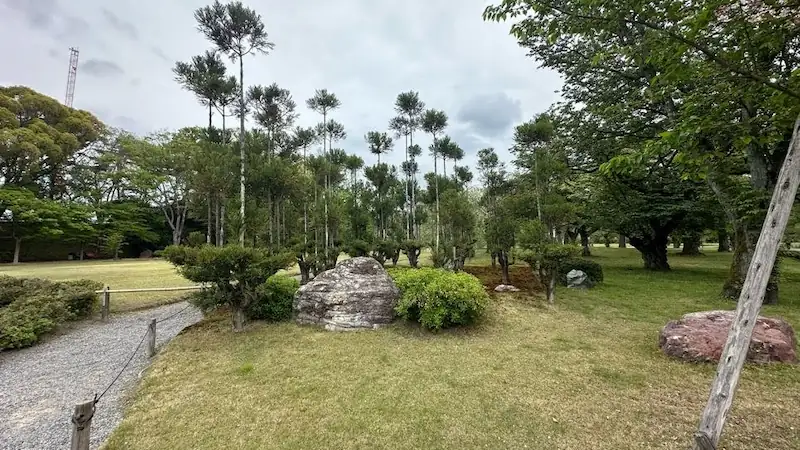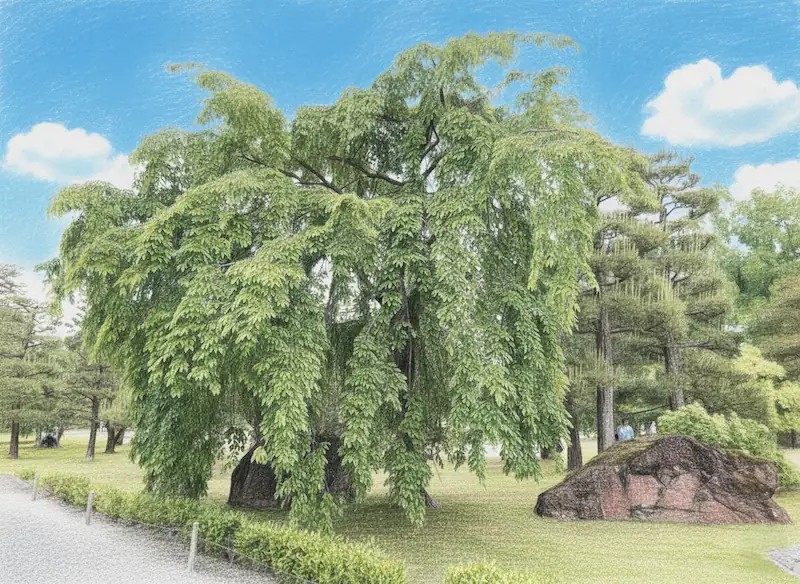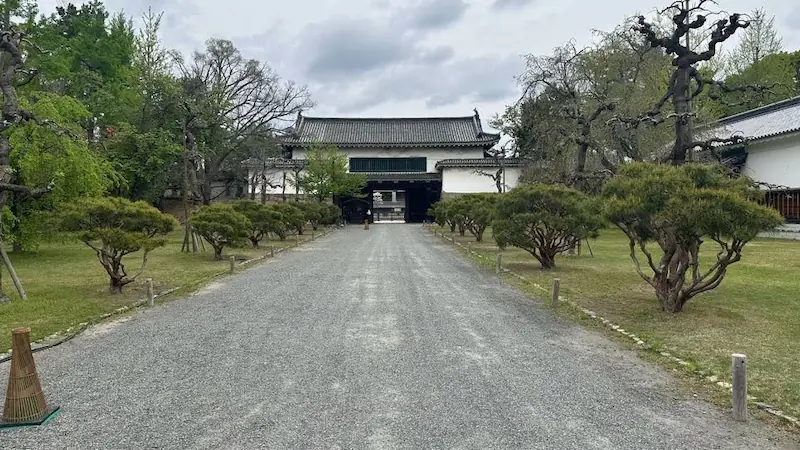A Route to Savor Nijo Castle’s “Other Kind of Beauty”
In contrast to the castle’s splendid palaces, Nijo Castle also unfolds spaces steeped in quiet and poise.
Seiryu-en Garden, where the tearoom Kōuntei rests; the rare “Weeping Pagoda Tree (Shidare Enju)” with its gracefully drooping branches; and the North Otemon Gate once trodden by shoguns and daimyo. Balancing elegance with utility, these places embody the castle’s serene aesthetic—where history and nature meet.
Seiryu-en Garden
⭐ Recommendation
Historical Significance: ☆☆ (A modern creation that still matters within Nijo Castle’s historical storyline)
Visual Appeal: ☆☆☆ (A refined blend of Japanese and Western landscaping)
Experiential Value: ☆☆ (Calm strolling garden; tearoom usage offers a contemplative experience)

Seiryu-en is a relatively new garden space on the north side of Nijo Castle. Its hallmark is a Japanese–Western hybrid design that juxtaposes a traditional pond-strolling garden with a Western-style lawn. Although created in the Showa era and not a direct site of shogunal events, its grounds overlap areas that once supported Tokugawa operations within the castle, so the garden still ties into the broader narrative of the shogunate here.
| Year Built | 1965 (Showa 40) |
|---|---|
| Developer | City of Kyoto (Landscape design by Kin-saku Nakane, et al.) |
| Structure & Features | Japanese pond garden + Western-style lawn in parallel |
| Alterations | No major post-construction changes noted |
| Current Status | Excellent (open to the public) |
| Loss/Damage | None |
| Cultural Property | No individual designation; the overall Nijo Castle site is a UNESCO World Heritage property |
| Notes | Includes the study building “Kōuntei” and the tearoom “Waraku-an.” Uses components relocated from the former residence of merchant Sumino-kura Ryōi. |
🗺 Address: 541 Nijojo-cho, Nakagyo Ward, Kyoto
🚶 Access
About a 1-minute walk (approx. 70 m) from Kōuntei
⏳ Suggested Time
Quick look: approx. 20–30 minutes
Leisurely visit: about 1 hour (sit and take in the view; include tearoom use)
📍 Highlights
- Kōuntei (Study/Reception Hall): A relocated study from the former residence of Sumino-kura Ryōi. Interior usually closed.
- Waraku-an (Tearoom): A tea space where visitors can enjoy matcha and sweets.
- Pond, Islets, Stepping Stones & Rockwork: On the west side, streams, stepping stones, and artful stone groupings emulate natural scenery.
- Lawn (Western Garden) Zone: The eastern lawn creates a Western-style vista—a deliberate contrast with the Japanese garden.
- Seasonal Planting & Cherries: Spring blossoms and autumn foliage color the garden, highlighting the passage of the seasons.
📌 Trivia
- Shogunal Connections: The Seiryu-en site once held residences for zai-ban (samurai stationed to guard the castle), tying it to shogunal security and daily operations. {index=6}
- Traces of the Tenshu (Main Keep): Some say part of the tenshu once stood in this vicinity; before the garden was laid out, related castle facilities are believed to have occupied the area. {index=7}
- Materials & Stones from Sumino-kura Ryōi: The landscaping incorporated garden stones and timbers from the magnate’s former residence, preserving historical links in the garden fabric. {index=8}
- Modern Hybrid Aesthetic: Built in the Showa period, the garden intentionally mixes traditional styles with then-modern design sensibilities.
Weeping Pagoda Tree (Shidare Enju)

🏛 Overview
The Weeping Pagoda Tree within Nijo Castle is prized for its elegant, pendulous branching. The pagoda tree (enju)—Styphnolobium japonicum, a leguminous deciduous tree—originated in China and has long been planted in Japanese temple and garden settings. The weeping cultivar is rare nationwide and especially eye-catching here.
In Nijo Castle’s tranquil setting, the tree offers a sense of calm. Its appearance shifts with the seasons, rewarding repeat visits with new moods throughout the year.
| Item | Details |
|---|---|
| Planted | Unknown |
| Planter | Unknown (likely planted by Nijo Castle administrators) |
| Botany & Features | Deciduous tree in the pea family; distinct weeping habit. Pale yellowish-white flowers in July–August; produces pod-like fruit. Associated with longevity in Japanese wordplay on “enju” (延寿). |
| Care & Maintenance | Unspecified; routine pruning and supplemental planting to maintain vigor. |
| Current Status | Extant; can be viewed on the grounds (around Seiryu-en and nearby areas). |
| Loss/Damage | No known record of loss or severe damage. |
| Cultural Property | Not designated; preserved as an ornamental tree. |
| Notes | This rare weeping form is a visitor favorite; summer flowers accent Seiryu-en’s vistas. |
🗺 Address:
541 Nijojo-cho, Nakagyo Ward, Kyoto
🚶 Access
Starting point: about a 1-minute walk (approx. 26 m) from Seiryu-en
⏳ Suggested Time
Quick look: ~10 minutes
Unhurried visit: ~20 minutes (to study the tree and surrounding views)
📍 Highlights
🔹 Distinct Silhouette:
The defining feature is its sweeping, drooping canopy—instantly recognizable and unlike most trees on the grounds.
🔹 Seasonal Interest:
Fresh spring greens, deep summer foliage and bloom, golden leaves in autumn, and an elegant winter tracery—seasonality is the point here.
🔹 Cultural Associations:
Historically revered as a “tree of learning,” the pagoda tree symbolizes scholarship and knowledge—fitting for Nijo Castle’s cultural side.
📌 Trivia
💡 From Officialdom to Elegance:
In China, the pagoda tree signified official rank; officials’ seats were called “kweza” (chairs of pagoda tree). Japan likewise treated the tree as noble, planting it at temples and castles.
💡 For Plant Enthusiasts:
The weeping cultivar is genuinely rare and prized for its unusual habit—making this a quiet favorite among garden lovers.
💡 Artists’ Inspiration:
While no direct celebrity tie is recorded, many cultural figures and artists visiting Nijo Castle are said to have been moved by the tree’s beauty.
North Otemon Gate

🏛 Overview
The North Otemon is a key gate on the castle’s north side, serving as a secondary counterpart to the main East Otemon Gate. A gate has stood here since the original construction in 1603 (Keicho 8), but whether the present structure dates from then or from rebuilding around Emperor Go-Mizunoo’s 1626 (Kanei 3) procession remains uncertain.
Because the Kyoto Shoshidai (the shogunate’s regional governor) maintained a residence across the road, the gate likely functioned as a liaison route between the two compounds.
| Item | Details |
|---|---|
| Year Built | 1625–1626 (Kanei era) |
| Builder | Attributed to works during the Tokugawa Iemitsu period |
| Structure & Features | Turret-gate form; hip-and-gabled, tiled roof. Located on the north side; functioned as a supporting gate to the East Otemon. Faced the Kyoto Shoshidai residence across the road; likely used for official transit. |
| Repairs & Restoration | Maintained repeatedly since construction; detailed restoration records are limited. |
| Current Status | Extant; designated an Important Cultural Property of Japan. |
| Loss/Damage | No clear record of catastrophic loss or burning. |
| Cultural Property | Important Cultural Property (Japan) |
| Notes | A gate existed here from the Keicho-period founding; whether this is that original or a Kanei-period rebuild is unclear. Served as a major northern entrance, second only to the East Otemon in scale and presence. |
🗺 Address:
541 Nijojo-cho, Nakagyo Ward, Kyoto
🚶 Access
Starting point: about a 5-minute walk (approx. 300 m) from the Weeping Pagoda Tree
⏳ Suggested Time
Quick look: ~10 minutes
Leisurely visit: ~20 minutes (to study the gate and surrounding defenses)
📍 Highlights
🔹 Gate Architecture:
A turret-gate with hip-and-gabled tiled roof, thick timber doors, and flanking stone walls—speaking to both authority and defense.
🔹 Defensive Context:
Former turrets and earthen walls once stood around the gate, forming part of the broader security system; some elements are now lost, but the layout rewards informed imagination.
🔹 Historical Role:
Due to its position opposite the Kyoto Shoshidai residence, the gate likely functioned as an official corridor between castle and government offices.
📌 Trivia
💡 Liaison to Authority:
Facing the Kyoto Shoshidai’s compound, the gate helped handle communications with this pivotal shogunal office.
💡 Quietly Grand:
Second only to the East Otemon in scale and dignity, it served as the principal northern entrance.
💡 Imperial Processions:
The gate is said to have played an important role during Emperor Go-Mizunoo’s 1626 progress, and it saw frequent passage by shoguns and daimyo.



comment